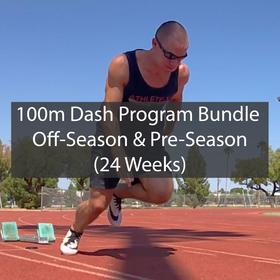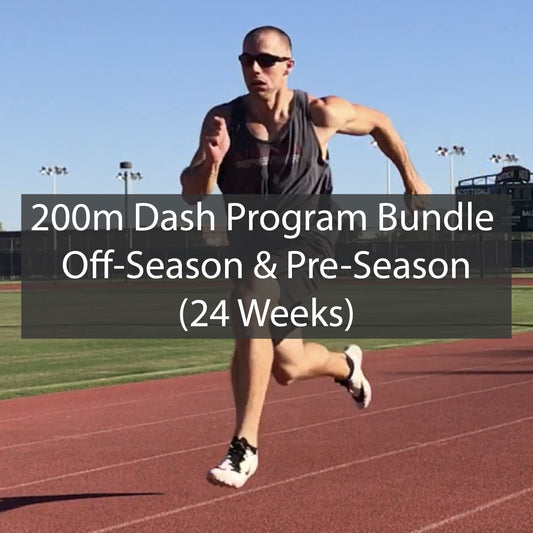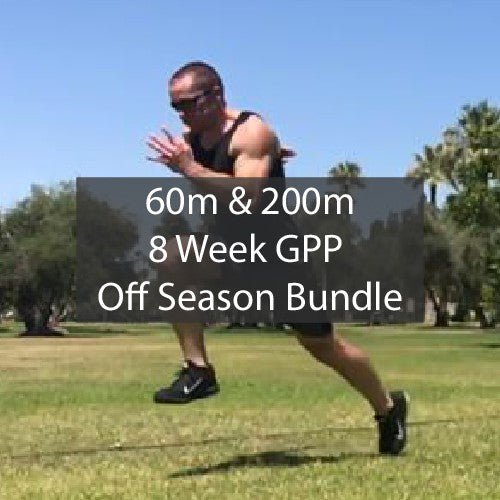100m Dash Training For Sprinters
100 Meter Dash Training - 100m Sprinting Workouts
100m dash training is one of the more popular areas of discussion within sports performance training, strength & conditioning, and injury prevention disciplines.
This is largely because the 100-meter dash is the race that typically decides who is considered the fastest person on earth.
What this page will cover:
- Useful Tools For Sprint Training
- Acceleration Training For The 100m Dash
- Speed Training For The 100m
- Strength & Power Training For The 100m
Training For The 100 Meter Dash
Given that the 100m dash lasts only 9 to 10 seconds at the highest levels of competition, 100m sprinters have little room for error. Because of this, 100m dash sprinting workouts must be performed throughout the year to prepare for competition.
How Sprinting Workouts Help 100m Sprinters
- Sprinting workouts develop the speed, power, and endurance required to sprint with maximal effort for 100 meters.
- Sprint training lets you rehearse the race and its parts - such as the acceleration phase, the maximal velocity phase, and the speed endurance & deceleration phase.
- Sprinting prevents injury by developing the ability of the body's tissues to handle the demands of sprinting at maximal intensity levels.
Sprinting workouts for the 100m dash include a variety of training methods, including:
- Acceleration Training
- Speed Training
- Endurance Training
- Strength & Power Training
- Resisted Sprint Training (Sled Sprints)
- Plyometric Training
To give you an idea of what these different types of training look like, below are some examples of sprinting workouts that can be used for a given purpose.
Useful Tools For 100m Dash Training
Some tools can be useful for athletes training for the 100-meter dash.
Here are a few articles you can check out which discuss these speed training tools & equipment:
- Enode Bar Speed Tracker
- Weight Vest For Running
- Sprint Sled For Resisted Sprinting
- Freelap Timing System
- Brower Timing System
Acceleration Training For The 100 Meter Dash
Acceleration is vital for 100m dash performance; some argue it is the most important aspect of the entire race. While people are free to say what is most important, what is undoubtedly true is that acceleration is an integral aspect of 100 meter dash sprinting performance. The faster you can explode off of the starting line and build up your speed, the better you will sprint in the 100m.
Because you must accelerate to reach maximal velocity (top speed), athletes practice with acceleration workouts for sprinters to develop the physical qualities and skills required to accelerate over as long a distance as effectively and to the highest velocity possible to win the 100-meter dash race.
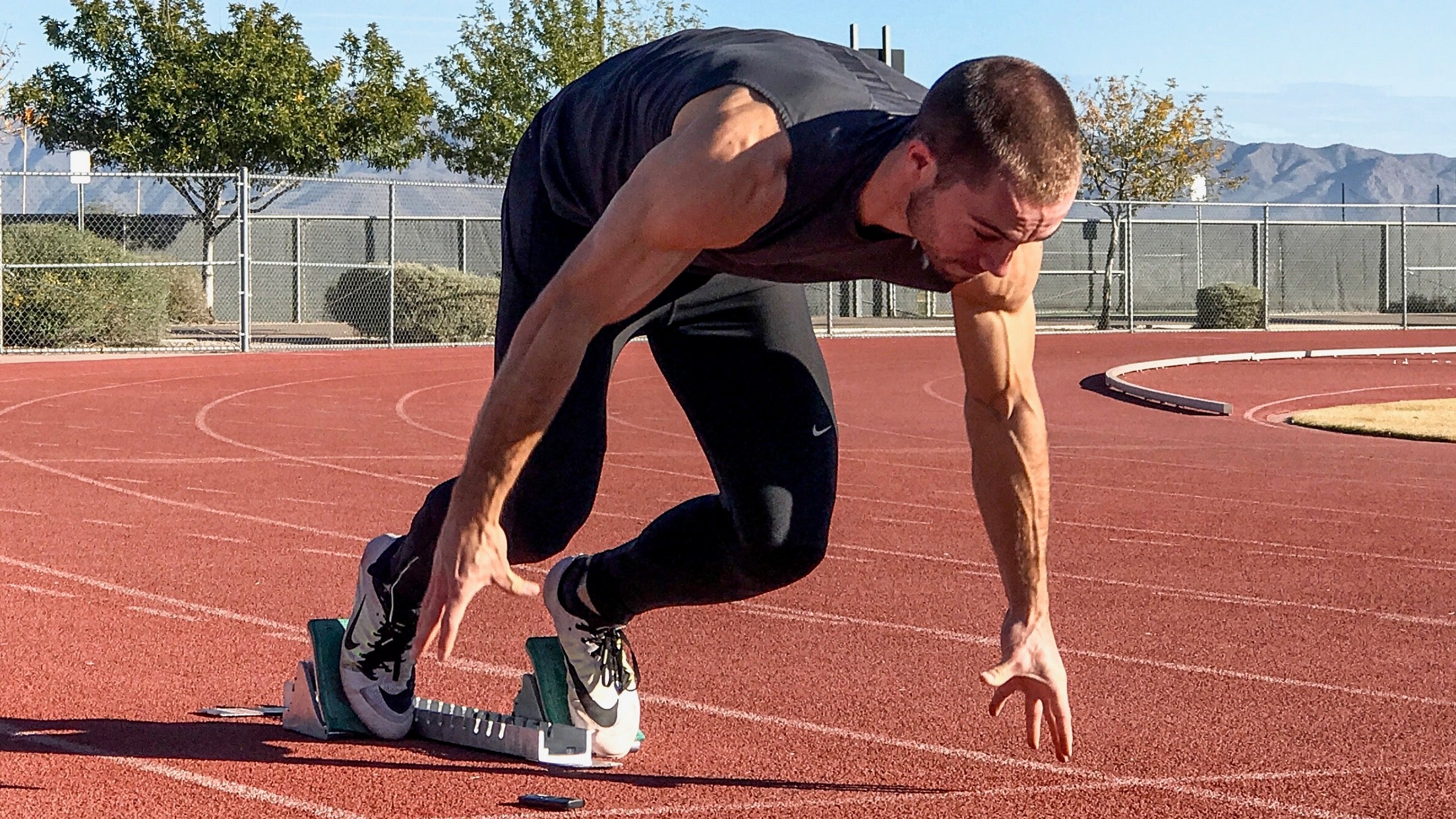
Acceleration Requires High Levels Of Force Production
To achieve high rates of acceleration, which last for large proportions of the 100m dash, athletes need to develop high forces at high velocities and orient these forces in a horizontal direction.
Elite sprinters are often pictured coming out of the blocks, launching at low angles. While they have practiced acceleration sprinting many times, the main reason these athletes can achieve low projection angles out of the blocks is that they can produce massive forces in a small amount of time.
By producing large forces, sprinters can accelerate while leaning forward to gain an advantage. Less explosive athletes will likely need a higher body angle to accelerate at their best to avoid falling and decelerating too soon.
Rapid propulsion forward & upward allows the elite sprinter to launch horizontally through the air without being pulled downward by gravity before their next stride. In contrast, weaker athletes lack the force production capabilities to allow for low block start angles and horizontally oriented postures during acceleration.
These athletes can try all they want to get low projection angles during early acceleration, but they will only achieve these angles when they can produce the forces required by the laws of physics.
Acceleration Requires Specific Skill & Conditioning Capabilities
Beyond the necessity for sprinters to produce high levels of force in short amounts of time, sprint athletes must perform sprinting workouts which develop the skills and specific conditioning required to sprint at maximal effort.
Acceleration sprinting consists of a series of steps, each increasing in horizontal velocity until reaching maximal speed. Sprinters must control their postural rise, foot placement, time spent on the ground, and overall sprinting rhythm.
Because sprinting takes place at maximal intensities, it is crucial not only to have the force & skills needed but also the level of conditioning which allows the athlete to train with repeated sprints at high velocities. By performing endurance training for sprinters, athletes can enhance their ability to train as well as their ability to compete.
Earlier in the year, athletes will need to focus more on work capacity with sprint capacity workouts.
In contrast, later in the year, the focus can shift to specific development, which in the case of acceleration would be acceleration development training.
100m Track Workouts For Acceleration
An example of an acceleration capacity workout that would take place earlier in the year would consist of something like this:
- Track Warmup
- 3 sets of 3x30m Sprints
- 45 seconds rest between sprints.
- 4 minutes rest between sets.
- 6x30m Alternate Leg Bounds
- 60 seconds rest between bounds.
In contrast, an example of an acceleration development workout taking place later in the training year would look something like this:
- Track Warmup
- 2x30m, 2x40m, 2x50m
- 2:30 minutes rest between sprints.
- 5 minutes rest between sets.
- 4x40m Weighted Straight Leg Bounds
- 60 seconds rest between bounds.
An acceleration development workout that utilizes resisted sprints could be performed in a couple of different ways.
Example 1:
- 1. Track Warmup
- 6x Resisted/Unresisted Sprint Contrasts
- 2a. Horizontally Resisted 30m (Using heavy resistance, such as 50-80% bodyweight, on a sled, Parachute or Exergenie)
- 2b. Unresisted 30m
- 90 seconds rest between sprints, 3 minutes between sets.
Example 2:
- 1. Track Warmup
- 2a. 2x Vertically Resisted 30m Sprints (Using a weighted vest at 4-8% bodyweight)
- 2b. 1x Unresisted 40m Sprint
- 90 seconds rest between sprints, 4 minutes between sets.
Strength & Power Workout For Acceleration
For acceleration, the exercises used in the gym should be tailored toward developing the body's ability to produce large forces at high velocities, preferably in horizontal directions, split stances, or a combination of both. Also, the athlete should train the hamstrings using knee & hip dominant, eccentric & elastic exercises that target the hamstrings.
Strength & power development training for sprinters can look like:
- 1a. Power Cleans - 5x2 @ 80%
- 1b. Split Depth Jump - 5x2
- 2a. Reactive Split Squat Drop - 4x2 per side at 60% + 100lb Band Tension
- 2b. Split Stance Box Jump - 4x2 per side
- 3a. Eccentric RDL - 4x5 @ 65% (Faster tempo)
- 3b. Band Hip Flexor Punch - 4x8 (Fast forward, slow back)
Speed Training For The 100 Meter Dash
While acceleration is the process by which we get up to maximal velocity, maximal velocity itself (a.k.a. top speed) separates the most elite sprinters from those who are simply above average.
In a professional sprint race, athletes achieve horizontal velocities well over 11 meters per second, and there is no doubt that the athlete with the highest top speed will have an advantage over the other sprinters in the race.

Maximal velocity is trained similarly to acceleration, with speed capacity workouts taking place earlier in the year, which transition into speed development over time. In addition to track workouts for speed, sprinters will perform plyometric and high-velocity strength training to improve their force production capabilities. Most important, though, is maximal velocity sprint training conducted at the track.
Speed Development Is A Marathon, Not A Sprint
Achieving high velocities when sprinting is not easy, and the challenge of attaining high speeds becomes greater as velocities increase. It is relatively more challenging for an athlete to go from 10.5 meters per second to 11.5 meters per second than improving from 9 meters per second to 10 meters per second.
Because of this, athletes need to look at speed development from a long-term, incremental improvement standpoint rather than a rapid process that happens in a matter of months.
As is the case with acceleration, speed training that takes place earlier in the year will be in the form of speed capacity training, which utilizes shorter rest periods and a higher number of repetitions to challenge the athlete's work capacity over distances that are typically used for speed development.
100 Meter Dash Training Programs
Once the athlete has developed this work capacity and ability to recover between sprints, the focus shifts toward speed development. Speed development workouts, also known as speed training or maximal velocity training, are performed over 30-70 meters (depending on the athlete's capabilities) at maximal intensity, using full or near-full recovery periods between sprints.
Track Workouts For Maximal Velocity (Speed Training)
An example of a speed capacity workout that occurs earlier in the year would consist of something like this:
- Track Warmup
- 4 sets of 2x50m Sprints
- 75 seconds rest between sprints.
- 6 minutes rest between sets.
- 4x12 Stiff Ankle Hops
In contrast, an example of a speed development workout taking place later in the training year would look something like this:
- 6x30m Flying Sprints
- 20-40m Acceleration -> 30m Maximal Velocity Zone
- 5-8 minutes rest between sprints
A speed development workout that utilizes resisted sprints could be performed in several different ways.
Speed Workout For The 100m - Example 1:
- 1. Track Warmup
- 6x Resisted/Unresisted Sprint Contrasts
- 2a. Horizontally Resisted 45m (Using light resistance, such as 5-10% bodyweight, on a sled or Exergenie)
- 2b. Unresisted 30m flying sprint from a skip-in start& 20-30m acceleration zone.
- 3 minutes rest between sprints, 6 minutes between sets.
Speed Workout For The 100m - Example 2:
- 1. Track Warmup
- 2a. 1x Vertically Resisted 20m Flying Sprints (Using a 4-6% bodyweight weighted vest)
- 2b. 1x Unresisted 50m Sprint
- 3 minutes rest between sprints, 5 minutes between sets.
Strength & Power Workout For Speed Development
Strength & power development training for maximal velocity is an area of debate. Still, it is generally accepted that a holistically stronger athlete will perform better in maximal velocity than a weak athlete, given that both athletes have body compositions conducive to sprinting.
For maximal velocity, the exercises used in the gym should be tailored toward developing the body's ability to strike the ground, absorb and produce large vertical forces, and to exhibit high levels of vertical stiffness (such as during the catch of a power clean or ground contact of a depth jump).

Sprinters training for speed in the gym should consider how long it takes to produce force in a given exercise, what velocities the weights or athlete's body are moving, and the direction of the force application.
Example Strength Training Workout For Sprinters:
- 1a. Hang Cleans - 5x2 @ 80%
- 1b. Depth Jumps - 5x2
- 2a. Low Box Step Up - 4x2 per side at 60% + 80lb Band Tension
- 2b. 6" A-Box Strike Jump - 4x2 per side
- 3a. Elastic Single Leg Back Extension - 4x5 (Faster tempo)
- 3b. Light Band Hip Flexor Cycle - 3x10 seconds per side.
Speed Endurance Training For The 100 Meter Dash
Last but not least, the last area of sprint-specific training that needs to be discussed regarding the 100-meter dash is of speed endurance training.
Typically at the end of a 100m race, the leaders accelerate away from the field. In reality, they are decelerating and a less rapid pace, while those who look like they're falling back are decelerating at a higher rate. Speed endurance training is used to develop the skill and capabilities needed to maintain speed and for training to resist this deceleration.
Speed endurance may be more or less of an important factor depending on the specific athlete, but ultimately all sprinters will need to train for speed endurance if they want to run fast over 100 meters.
Speed Endurance - Dependent On Skill & Physiology
As with anything sprinting-related, speed endurance requires both the physiological capabilities to sprint fast over long durations and the skill of maintaining proper technique and posture.
An athlete may have exemplary physical endurance qualities in the gym but need more transfer to sprint, as they need to have the sprinting skill to maintain their speed. Similarly, a highly skilled short sprinter may need more physiological abilities fundamental to sprinting over long distances at high velocities.
Because of this, training for speed endurance needs to incorporate both physical and mental qualities, giving athletes cues to help and exposure to the workloads which stimulate the body's recovery mechanisms.
Sprinting Workouts For Speed Endurance
Speed endurance training for 100 meter dash sprinters can be broken down into two primary categories: short-speed endurance and long-speed endurance. In general, the sprinter should progress from shorter to longer speed endurance workouts throughout the year but can also blend distances into a single workout from time to time.
A short speed endurance workout in the middle of the pre-season could look something like this:
- Track Warmup
- 2x60m, 2x80m 2x100m (5-10 minutes rest)
- 3x80m Straight Leg Bounds
A long speed endurance workout that is used just before the competitive season could consist of the following:
- Track Warmup
- 1x200m, 1x180m, 1x150m, 1x120m
Lastly, one could utilize a weighted vest to increase the endurance demands of shorter sprints. For example, if an 8% bodyweight weighted vest causes a 10% decrease in speed, an athlete could perform 60m sprints but get 7-9 seconds of work out of them instead of the typical 6-7 seconds.
Short Speed Endurance With A Weighted Vest - Workout Example:
- 1. Track Warmup
- 2. 3x50m (Weighted Vest)
- 3. 3x80m (Unweighted)
Another form of speed endurance training you can utilize are ins & outs, also known as speed change workouts.
Instead of sprinting as fast as possible for the entire sprint, the ins and outs are done with alternating segments of all-out sprinting and relaxed, sub-maximal sprinting.
For example, you may accelerate maximally for 40 meters, then alternate every 10 meters between 90% and 100% intensity sprinting.
Variations of Ins & Outs For 100m Sprinters:
- Accelerate for 30 meters, then alternate speed every 10 meters for an additional 50 meters.
- Accelerate over 50 meters, float for 50 meters, then sprint fast again for a final 50 meter segment.
Ins & outs can be useful for learning to relax at high speeds and for sprinters to feel what it is like to shift gears and increase to maximal velocity. These workouts also allow you to do more sprinting volume since some parts of the sprint reps are done at sub-maximal intensities.
Alternative Endurance Training Methods For Sprinters
Endurance training for sprinters can incorporate training methods outside of pure sprinting, including endurance bounds, endurance drills, tempo endurance, and aerobic strength training.
Is 11 Seconds Good For 100m Times?
11 seconds is a good 100m time, especially for high school athletes.
Breaking 11 seconds in the 100 meter dash is the goal of most sprinters, as this is attainable by good athletes who train well and focus on improving their skills.
If you can run 11 seconds in the 100 meter dash, you should be happy with yourself and motivated to continue training to break the 11-second barrier.
You can check the latest 100 meter dash rankings on World Athletics to see where you stand among the world's best sprinters.
What Is The World Record In The 100 Meter Dash?
- Men's 100 Meter Dash World Record: 9.58
- Women's 100 Meter Dash World Record: 10.49
Usain Bolt holds the men's 100m world record in a stunning 9.58 seconds, which he set at the 2009 Athletics World Championships in Berlin, Germany.
Florence Griffith-Joyner has the world record for the women's 100m, running 10.49 seconds in the quarter-final of the 1988 USA Olympic Trials in Indianapolis.

Online Training Group
Get workouts sent to your phone to help you get stronger, sprint faster, and jump explosively.
Sprint Training Articles
View all-
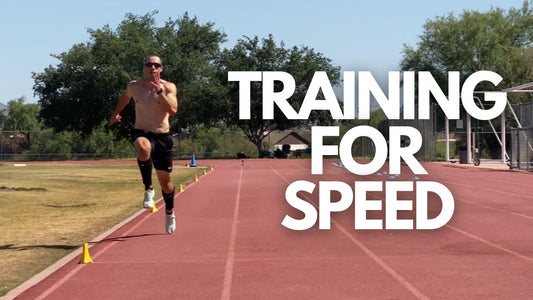
Training For Speed - Methods, Progressions & Ti...
Speed training is fundamentally the primary way to train in order to sprint faster. Social media influencers and coaches throw the term speed training around loosely, when in reality it...
Training For Speed - Methods, Progressions & Ti...
Speed training is fundamentally the primary way to train in order to sprint faster. Social media influencers and coaches throw the term speed training around loosely, when in reality it...
-
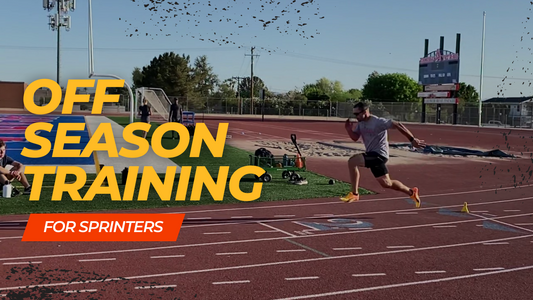
How Should Sprinters Train In Their Off Season?
After a long season of training and competition, many sprinters find themselves wondering what they should do once the season has come to a close. Some continue to train hard,...
How Should Sprinters Train In Their Off Season?
After a long season of training and competition, many sprinters find themselves wondering what they should do once the season has come to a close. Some continue to train hard,...
-
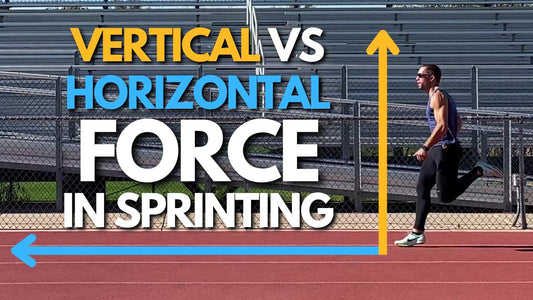
Force Production In Sprinting | Is Vertical Or ...
In discussions surrounding sprint performance, coaches and researchers have debated whether vertical force or horizontal force is more important for running fast. While many will pick a side and claim...
Force Production In Sprinting | Is Vertical Or ...
In discussions surrounding sprint performance, coaches and researchers have debated whether vertical force or horizontal force is more important for running fast. While many will pick a side and claim...
Sprint Training Programs
-
100 Meter Dash Training Program Off-Season & Pre-Season Bundle
Regular price $47.00 USDRegular priceUnit price / per$99.00 USDSale price $47.00 USDSale -
400m Dash Off-Season & Pre-Season Training Program Bundle
Regular price $47.00 USDRegular priceUnit price / per$95.97 USDSale price $47.00 USDSale -
200m Dash Off-Season & Pre-Season Training Program Bundle
Regular price $47.00 USDRegular priceUnit price / per$95.97 USDSale price $47.00 USDSale -
Indoor Off Season Bundle - 60 Meter & 200 Meter Dash GPP Training Programs
Regular price $62.00 USDRegular priceUnit price / per$78.00 USDSale price $62.00 USDSale




